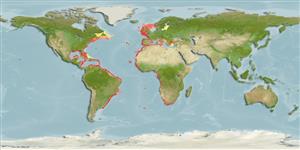Common names from other countries
>
Scombriformes (Mackerels) >
Scombridae (Mackerels, tunas, bonitos) > Scombrinae
Etymology: Sarda: Latin and Greek, sarda = sardine; name related to the island of Sardinia (Ref. 45335).
More on author: Bloch.
Environment: milieu / climate zone / depth range / distribution range
Sinh thái học
Biển; Thuộc về nước lợ; Ở đại duơng, biển (Ref. 51243); Mức độ sâu 80 - 200 m (Ref. 5377). Subtropical; 12°C - 27°C (Ref. 168); 62°N - 40°S, 98°W - 42°E (Ref. 54865)
Eastern Atlantic: Oslo, Norway to Port Elizabeth, South Africa. Also known from the Mediterranean and Black Sea. Western Atlantic: Nova Scotia, Canada to Florida, USA and northern Gulf of Mexico; then from Colombia, Venezuela, and south of the Amazon River to northern Argentina; apparently absent from most of the Caribbean Sea.
Length at first maturity / Bộ gần gũi / Khối lượng (Trọng lượng) / Age
Maturity: Lm 37.8, range 41 - ? cm
Max length : 91.4 cm FL con đực/không giới tính; (Ref. 168); common length : 50.0 cm FL con đực/không giới tính; (Ref. 168); Khối lượng cực đại được công bố: 11.0 kg (Ref. 40637); Tuổi cực đại được báo cáo: 5 các năm (Ref. 29114)
Các tia vây lưng cứng (tổng cộng) : 20 - 23; Các vây lưng mềm (tổng cộng) : 15 - 18; Tia cứng vây hậu môn: 0; Tia mềm vây hậu môn: 14 - 17; Động vật có xương sống: 50 - 55. Mouth moderately large. Laminae of olfactory rosette 21-39. Interpelvic process small and bifid. Body completely covered with very small scales posterior to the corselet. Swim bladder absent. Spleen large. Liver with elongate left and right lobe and short middle lobe. Oblique dorsal stripes with a greater angle than in other species of Sarda.
Epipelagic, neritic and schooling species that may enter estuaries. Known to be cannibalistic, adults prey on small schooling fishes, invertebrates like squid and shrimps and can swallow relatively large prey. Eggs and larvae pelagic (Ref. 6769). Utilized fresh, dried or salted, smoked, canned and frozen (Ref. 9987). Able to adapt to different temperatures 12° to 27°C and salinities 14 to 39 (Ref. 36731).
Collette, B.B. and C.E. Nauen, 1983. FAO Species Catalogue. Vol. 2. Scombrids of the world. An annotated and illustrated catalogue of tunas, mackerels, bonitos and related species known to date. Rome: FAO. FAO Fish. Synop. 125(2):137 p. (Ref. 168)
IUCN Red List Status (Ref. 130435)
CITES (Ref. 128078)
Not Evaluated
Threat to humans
Reports of ciguatera poisoning (Ref. 30303)
Human uses
Các nghề cá: tính thương mại cao; cá để chơi: đúng
Các công cụ
Special reports
Download XML
Các nguồn internet
Estimates based on models
Preferred temperature (Ref.
115969): 7 - 23.4, mean 10.7 (based on 346 cells).
Phylogenetic diversity index (Ref.
82804): PD
50 = 0.5312 [Uniqueness, from 0.5 = low to 2.0 = high].
Bayesian length-weight: a=0.00871 (0.00764 - 0.00993), b=3.06 (3.02 - 3.10), in cm Total Length, based on LWR estimates for this species (Ref.
93245).
Mức dinh dưỡng (Ref.
69278): 4.5 ±0.0 se; based on diet studies.
Thích nghi nhanh (Ref.
120179): Trung bình, thời gian nhân đôi của chủng quần tối thiểu là 1.4 - 4.4 năm (K=0.13-0.24; tm=1; tmax=5).
Prior r = 0.57, 95% CL = 0.37 - 0.85, Based on 9 data-limited stock assessments.
Fishing Vulnerability (Ref.
59153): Low to moderate vulnerability (33 of 100).
Climate Vulnerability (Ref.
125649): Moderate to high vulnerability (48 of 100).
